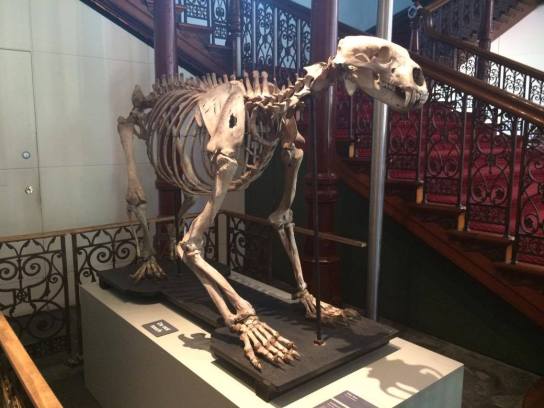 Image: Albrecht Dürer, Rhinoceros, 1515
Image: Albrecht Dürer, Rhinoceros, 1515
What: Curious Beasts: Animal Prints from Dürer to Goya
Where: South Australian Museum
When: Open 10.00 am – 5.00 pm daily until 5 February 2017
How much: Children 5-15 $5, concession $14, adults $17, free for Museum Members

Image: Polar bear skeleton at the South Australian Museum (Credit: Matilda Handsley-Davis)
Humans have always been enthralled by curious beasts. Myths and legends from almost every culture in the world are populated by creatures such as mermaids, dragons, and human-animal hybrids or shape-shifters. Many scientific voyages have been, and continue to be, inspired by a search for new and wondrous life forms. The exhibition Curious Beasts: Animal Prints from Dürer to Goya, currently showing at the South Australian Museum, reflects and pays tribute to this human fascination with the animal world. The focus is mostly from a Western European perspective, although Aboriginal and Torres Strait Islander cultures are also featured.

Image: George Cruikshank, The mermaid!, 1822
Curious Beasts bring together a selection of rare prints from the British Museum and specimens from the South Australian Museum’s own collection. Prints on display date back as far as the 15th century, and, as the exhibition title suggests, include works by famous artists such as Albrecht Dürer and Francisco Goya. Hosting the exhibition is a coup for the Museum, as this is the only location in the Southern Hemisphere where these unusual prints will be displayed before being returned to storage. If that weren’t special enough, some of the specimens belonging to the Museum itself have never been shown to the public before.

Image: The British Museum, home of the prints on display in Curious Beasts (Credit: The British Museum)
A key theme of the exhibition is the power of the printed image in cultural consciousness. This was also the focus of the accompanying lecture, Curious Beasts: Antipodean Creatures in the European Imagination, delivered by Professor Sasha Grishin on the 23rd of November. In his lecture, Professor Grishin discussed the authority of the printed image in Western culture.
 Image: Francis Barlow, A true representation of … the Elephant and the Rhinoceros, 1685
Image: Francis Barlow, A true representation of … the Elephant and the Rhinoceros, 1685
The endurance of Dürer’s Rhinoceros (1515), a copy of which is displayed in Curious Beasts, is a prime example of this authority. Dürer had never seen a rhinoceros, but produced this image based on a description of a real rhinoceros that had arrived in Portugal from India in 1515. He added one or two fanciful details, including armour-like scales and an additional horn at the rhino’s shoulders. Also of note is the composition of the print, with the animal almost squeezed into a space too small for it, conveying a sense of mass and “pent-up force”. Grishin argues that Dürer and other early modern Europeans were influenced in their perception of the rhinoceros by its semi-mythical status as the ‘monoceros’ found in medieval bestiaries and heraldry – a war-like creature and mortal enemy of the elephant.
 Image: Salvador Dali, Rhinoceros cosmique, 1956
Image: Salvador Dali, Rhinoceros cosmique, 1956
Turning to another print featured in Curious Beasts, a 1685 mezzotint by Francis Barlow, Grishin notes that the (to modern eyes) bizarre and overly-armoured depiction of the rhinoceros, complete with supposed hatred of the elephant, is retained – despite the fact that Barlow had most likely seen a rhinoceros in real life, as there was one living not far from his studio. Indeed, this view of the rhinoceros endures through the ages, with Dürer’s image in particular continuing to influence representations well into the 20th century.
 Image: Niki de Saint Phalle, Rhino, 1999
Image: Niki de Saint Phalle, Rhino, 1999
Closer to home, much the same story can be told about early European representations of Australian animals, such as George Stubbs’ A portrait of the kongouro [kangaroo] from New Holland (1772) and Charles-Alexandre Le Sueur’s The wombat (1807). Stubbs’ rather inaccurate kangaroo portrait, based a piece of skin, a skull, and possibly one or two drawings from James Cook’s first voyage of discovery, was the basis for the kangaroo on the ‘Bowman flag’ on which Australia’s official coat of arms is based. Echoes of Stubbs’ “kongouro” are also present in the work of Danie Mellor, an Aboriginal Australian artist whose work focuses on the invasion and colonisation of Australia.
 Image: George Stubbs, A portrait of the kongouro from New Holland, 1772
Image: George Stubbs, A portrait of the kongouro from New Holland, 1772
As the viewer moves through the exhibition space, we are encouraged to make our own comparisons between printed images and reality. Often, the British Museum prints are displayed in juxtaposition with specimens from the Museum’s collection – so, for example, having just looked at a cartoon poster about ostriches, we rounded the corner and were faced with an impressively large stuffed ostrich. Similarly, a print of an ichthyosaur skull discovered in 19th-century England is displayed opposite an ichthyosaur jawbone fossil from the Museum.
 Image: Danie Mellor, kangaroo sculpture, 2009
Image: Danie Mellor, kangaroo sculpture, 2009
Of course, it can be argued that there is still an element of artifice in a museum specimen – the contributions of the collector, the taxidermist, and the viewer serve to position these animals in a human context, just as the role of the artist or printer does for a printed image. Still, the contrasts between the more scientific and the more artistic or poetic approaches to the animal kingdom are thought-provoking. More broadly, Curious Beasts invites us to consider the myriad ways in which humans have related to animals through history, and the different meanings – food, companions, myths, curiosities, symbols, or scientific specimens – that we have assigned to them. I highly recommend this fascinating exhibition.
4 out of 5 stars
